 W
WAcostasaurus is an extinct genus of possibly Thalassophonean pliosaurid known from the Barremian of the Paja Formation, Colombia. The type specimen, UNDG R-1000, is known from a near complete skull, and postcranial elements including a complete hindlimb and various vertebrae. The specimen has an estimated size of around 4 to 5 metres long.
 W
WAmargasaurus is a genus of sauropod dinosaur from the Early Cretaceous epoch of what is now Argentina. The only known skeleton was discovered in 1984 and is virtually complete, including a fragmentary skull, making Amargasaurus one of the best-known sauropods of its epoch. Amargasaurus was first described in 1991 and contains a single known species, Amargasaurus cazaui. It was a large animal, but small for a sauropod, reaching 9 to 10 meters in length. Most distinctively, it sported two parallel rows of tall spines down its neck and back, taller than in any other known sauropod. In life, these spines most likely could have stuck out of the body as solitary structures that supported a keratinous sheath. An alternate hypothesis, now less favored, postulates that they could have formed a scaffold supporting a skin sail. They might have been used for display, combat, or defense.
Annuloceras is an extinct genus of ammonite cephalopod. Its fossils are found in Lower Barremian sediments from California. The genus is currently placed in the family Aegocrioceratidae.
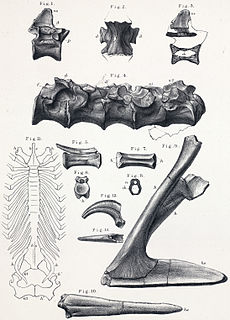 W
WAristosuchus is a genus of small coelurosaurian dinosaur whose name was derived from the Greek ἄριστος and σουχος. It shared many characteristics with birds.
 W
WBaryonyx is a genus of theropod dinosaur which lived in the Barremian stage of the Early Cretaceous period, about 130–125 million years ago. The first skeleton was discovered in 1983 in the Weald Clay Formation of Surrey, England, and became the holotype specimen of Baryonyx walkeri, named by palaeontologists Alan J. Charig and Angela C. Milner in 1986. The generic name, Baryonyx, means "heavy claw" and alludes to the animal's very large claw on the first finger; the specific name, walkeri, refers to its discoverer, amateur fossil collector William J. Walker. The holotype specimen is one of the most complete theropod skeletons from the UK, and its discovery attracted media attention. Specimens later discovered in other parts of the United Kingdom and Iberia have also been assigned to the genus.
 W
WCalamosaurus was a genus of small theropod dinosaur from the Barremian-age Lower Cretaceous Wessex Formation of the Isle of Wight, England. It is based on two cervical vertebrae, collected by Reverend William Fox.
 W
WCamarillasaurus is a genus of theropod dinosaur from the Early Cretaceous Period (Barremian) of Camarillas, Teruel Province, in what is now northeastern Spain. It may have been a spinosaur, according to a 2019 paper, or a ceratosaur, according to the 2014 paper in which it was described.
 W
WCaulkicephalus is a genus of ornithocheirid pterosaur from the Isle of Wight off the coast of England. It lived during the Early Cretaceous period, about 130 million years ago.
 W
WChangmiania is a genus of basal ornithopod dinosaur that lived in what is now China during the Early Cretaceous. It contains a single species, Changmiania liaoningensis.
 W
WChondrosteosaurus was a sauropod from Early Cretaceous England.
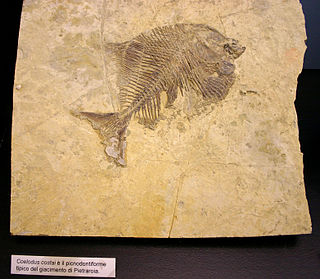 W
WCoelodus is an extinct genus of pycnodontiform fish from the Late Jurassic to early Paleocene (Danian). Fossils of the genus have been found in:JurassicGardies, FranceCretaceousYacoraite Formation, Argentina El Molino Formation, Bolivia Baharîje Formation, Egypt Ahlen and Bückeberg Formations, Germany Nimar Formation, India Alburni, Italy Damergou, Zinder, Niger Cochirleni Formation, Romania La Huérguina and Cabana Formations, Spain Pierre Shale, Kansas Tunbridge Wells Sand Formation, England Tucumcari Formation, New Mexico Twin Mountains and Paluxy Formations, TexasPaleoceneTremp Formation, Spain
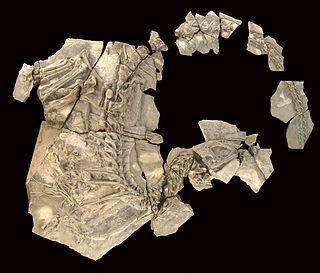 W
WConcavenator is a genus of theropod dinosaur that lived approximately 130 million years ago during the early Cretaceous period. The type species is C. corcovatus; Concavenator corcovatus means "Cuenca hunter with a hump". The fossil was discovered in the Las Hoyas fossil site of Spain by paleontologists José Luis Sanz, Francisco Ortega and Fernando Escaso from the Autonomous University of Madrid and the National University of Distance Education.
 W
WCraterosaurus was a genus of stegosaurid dinosaur. It lived during the Early Cretaceous around 145-136 million years ago. Its fossils were found in the Woburn Sands Formation of England. Craterosaurus may actually be a junior synonym of Regnosaurus, but only one fossil, a partial vertebra, was recovered.
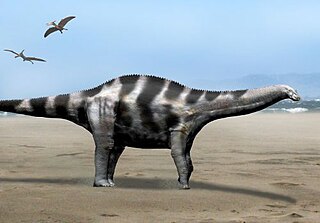 W
WDemandasaurus is a genus of rebbachisaurid sauropod dinosaur from early Cretaceous deposits of Spain. Demandasaurus is known from an incomplete but associated skeleton that includes cranial and postcranial remains. It was collected from the Castrillo de la Reina Formation in Burgos Province of Spain. It was first named by Fidel Torcida Fernández-Baldor, José Ignacio Canudo, Pedro Huerta, Diego Montero, Xabier Pereda Suberbiola and Leonardo Salgado in 2011 and the type species is Demandasaurus darwini.
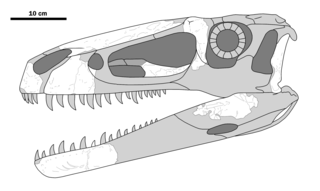 W
WEotyrannus is a genus of tyrannosauroid theropod dinosaur hailing from the Early Cretaceous Wessex Formation beds, included in Wealden Group, located in the southwest coast of the Isle of Wight, United Kingdom. The remains (MIWG1997.550), consisting of assorted skull, axial skeleton and appendicular skeleton elements, from a juvenile or subadult, found in a plant debris clay bed, were described by Hutt et al. in early 2001. The etymology of the generic name refers to the animals classification as an early tyrannosaur or "tyrant lizard", while the specific name honors the discoverer of the fossil.
 W
WFukuisaurus is a genus of herbivorous ornithopod dinosaur that lived during the Early Cretaceous in what is now Japan. The type species is F. tetoriensis, which was named and described in 2003.
 W
WGideonmantellia is an extinct genus of basal ornithopod dinosaur known from the Early Cretaceous Camarillas Formation of Galve, Province of Teruel, Spain. It contains a single species, Gideonmantellia amosanjuanae.
 W
WGobiconodon is an extinct genus of carnivorous mammal from the early Cretaceous. It weighed 10–12 pounds (4.5–5.4 kg) and measured 18–20 inches (460–510 mm). It was one of the largest mammals known from the Mesozoic. Like other gobiconodontids, it possesses several speciations towards carnivory, such as shearing molar teeth, large canine-like incisors and powerful jaw and forelimb musculature, indicating that it probably fed on vertebrate prey; rather uniquely among predatory mammals and other eutriconodonts, the lower canines were vestigial, with the first lower incisor pair having become massive and canine-like. Like the larger Repenomamus there might be some evidence of scavenging.
 W
WHypsilophodon is an ornithischian dinosaur genus from the Early Cretaceous period of England. It has traditionally been considered an early member of the group Ornithopoda, but recent research has put this into question.
 W
WIncisivosaurus is a genus of small, probably herbivorous theropod dinosaurs from the early Cretaceous Period of what is now the People's Republic of China. The first specimen to be described, IVPP V13326, is a skull that was collected from the lowermost levels of the Yixian Formation (dating to the Barremian stage about 126 million years ago in the Sihetun area, near Beipiao City, in western Liaoning Province. The most significant, and highly unusual, characteristic of this dinosaur is its apparent adaptation to an herbivorous or omnivorous lifestyle. It was named for its prominent, rodent-like front teeth, which show wear patterns commonly found in plant-eating dinosaurs. The specific name gauthieri honors Dr. Jacques Gauthier, a pioneer of the phylogenetic method of classification.
 W
WIstiodactylus is a genus of pterosaur that lived during the Early Cretaceous period, about 120 million years ago. The first fossil was discovered on the English Isle of Wight in 1887, and in 1901 became the holotype specimen of a new species, O. latidens, in the genus Ornithodesmus. This species was moved to its own genus, Istiodactylus, in 2001; this name is Greek for "sail finger". More specimens were described in 1913, and Istiodactylus was the only pterosaur known from three-dimensionally preserved fossils for much of the 20th century. In 2006, a species from China, I. sinensis, was assigned to Istiodactylus, but it has since been found to belong to a different genus.
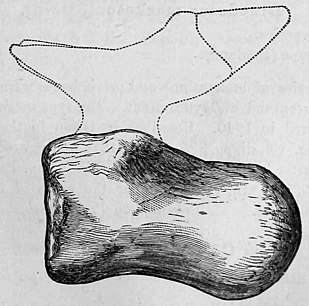 W
WIuticosaurus is a genus of titanosaur sauropod dinosaur from the Early Cretaceous of the Isle of Wight. Two species have been named: I. valdensis and I. lydekkeri. I. valdensis was found in the Wessex Formation and I. lydekkeri in the younger Upper Greensand.
 W
WKinnareemimus is a genus of ornithomimosaurian theropod dinosaur from Thailand. It is known only from incomplete remains including vertebrae, partial pubic bones, metatarsals, and an incomplete fibula. The third metatarsal exhibits a distinctive lateral "pinching", known as the "arctometarsalian" condition, variations of which are found in ornithomimosaurs, tyrannosauroids, troodontids, and caenagnathids. Its remains were collected from the Early Cretaceous Sao Khua Formation, dating to the Barremian stage, at Phu Wiang, Khon Kaen Province. Its early occurrence makes it among the earliest ornithomimosaur known, depending on the age of the formation. Buffetaut et al. suggest the fossils of Kinnareemimus may indicate an Asian origin for advanced ornithomimosaurs.
 W
WKrokolithes is an oogenus of Crocodiloid eggs. These eggs were laid by an extinct species of Crocodylian. It contains three oospecies, "K. dinophilus", K. wilsoni and K. helleri.
 W
WLebanese amber is fossilized resin found in Lebanon and southwest Syria. It is dates back approximately 130-125 million years to the Barremian of the Early Cretaceous. It formed on what was then the northerrn coast of Gondwana, believed to be a tropical or subtropical zone in a temperate or hot climate. It is the oldest source of amber with a significant number of inclusions. Up to 300 sources of Lebanese amber have been recovered and 17 of them are important sources of organic inclusions, which are the oldest of their kind. The inclusions help to document Cretaceous fauna and flora.
 W
WMorelladon is an extinct genus of herbivorous styracosternan ornithopod dinosaur. It lived during the Early Cretaceous of Spain, around 130 million years ago.
 W
WNeovenator (nee-o-ven-a-tor), which means "new hunter", is a genus of allosauroid dinosaur. At the time of its discovery on the Isle of Wight, United Kingdom, it was the best-known large carnivorous dinosaur from the Early Cretaceous period of what is now Europe.
 W
WOrnithodesmus is a genus of small, dromaeosaurid dinosaur from the Isle of Wight in England, dating to about 125 million years ago. The name was originally assigned to a bird-like sacrum, initially believed to come from a bird and subsequently identified as a pterosaur. More complete pterosaur remains were later assigned to Ornithodesmus, until recently a detailed analysis determined that the original specimen in fact came from a small theropod, specifically a dromaeosaur. All pterosaurian material previously assigned to this genus has been renamed Istiodactylus.
 W
WOrnithopsis was a medium-sized Early Cretaceous sauropod dinosaur, from England. The type species, which is the only species seen as valid today, is O. hulkei.
 W
WPlatypterygius is an ichthyosaur of the family Ophthalmosauridae. It is most closely related to the genera Caypullisaurus and Brachypterygius. The ichthyosaur lived from the Early Cretaceous (Hauterivian) to the earliest Late Cretaceous (Cenomanian) and had a cosmopolitan distribution.
 W
WPolacanthus, deriving its name from the Ancient Greek polys-/πολύς- "many" and akantha/ἄκανθα "thorn" or "prickle", is an early armoured, spiked, plant-eating ankylosaurian dinosaur from the early Cretaceous period of England.
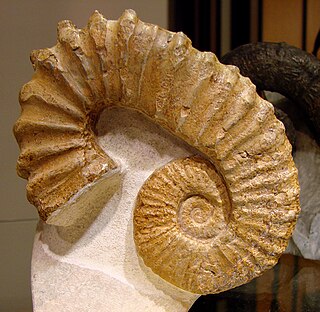 W
WPseudocrioceras is an extinct genus of ammonites. The species Pseudocrioceras anthulai has been found in strata from the Barremian - Aptian age of Chipatá, Santander, Colombia and is known from Georgia and Dagestan. The species Pseudocrioceras duvalianum and Pseudocrioceras fasciculare are found in the Barremian of France.
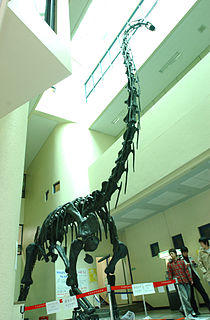 W
WPukyongosaurus is a genus of titanosauriform dinosaur that lived in South Korea during the Early Cretaceous period. It may have been closely related to Euhelopus, and is known from a series of vertebrae in the neck and back. The characteristics that were originally used to distinguish this genus have been criticized as being either widespread or too poorly preserved to evaluate, rendering the genus an indeterminate nomen dubium among titanosauriforms.
 W
WRegnosaurus is a genus of herbivorous stegosaurian dinosaur that lived during the Early Cretaceous Period in what is now England.
 W
WSachicasaurus is an extinct genus of brachauchenine pliosaurid known from the Barremian of the Paja Formation, Altiplano Cundiboyacense in the Colombian Eastern Ranges of the Andes. The type species is S. vitae.
 W
WSiamosaurus is a genus of spinosaurid dinosaur that lived in what is now Thailand during the Early Cretaceous period and is the first reported spinosaurid from Asia. It is confidently known only from tooth fossils; the first were found in the Sao Khua Formation, with more teeth later recovered from the younger Khok Kruat Formation. The type species Siamosaurus suteethorni, whose name honours Thai palaeontologist Varavudh Suteethorn, was formally described in 1986. In 2009, four teeth from China previously attributed to a pliosaur—under the species "Sinopliosaurus" fusuiensis—were identified as those of a spinosaurid, possibly Siamosaurus. It is yet to be determined if two partial spinosaurid skeletons from Thailand and an isolated tooth from Japan also belong to Siamosaurus.
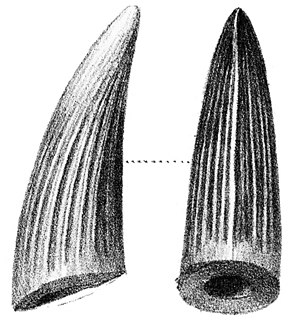 W
WSuchosaurus is a spinosaurid dinosaur from Cretaceous England and Portugal, originally believed to be a genus of crocodile. The type material, consisting of teeth, was used by British palaeontologist Richard Owen to name the species S. cultridens in 1841. Later in 1897, French palaeontologist Henri-Émile Sauvage named a second species, S. girardi, based on two fragments from the mandible and one tooth discovered in Portugal. Suchosaurus is possibly a senior synonym of the contemporary spinosaurid Baryonyx, but is usually considered a dubious name due to the paucity of its remains. In the Wadhurst Clay Formation of what is now southern England, Suchosaurus lived alongside other dinosaurs, as well as plesiosaurs, mammals, and crocodyliforms.
 W
WTastavinsaurus is a genus of sauropod dinosaur belonging to the Titanosauriformes. It is based on a partial skeleton from the Early Cretaceous Xert Formation of Spain. The type species is Tastavinsaurus sanzi, named in honor of the Rio Tastavins in Spain and Spanish paleontologist José Luis Sanz.
 W
WThecocoelurus is a dubious genus of theropod dinosaur from the early Cretaceous period of England. It is paleontologically significant for being one of the first ornithomimosaur specimens known from England and represents the earliest record of Ornithomimosauria in Europe.
 W
WValdosaurus is a genus of bipedal herbivorous iguanodont ornithopod dinosaur found on the Isle of Wight and elsewhere in England, Spain and possibly also Romania. It lived during the Early Cretaceous.
 W
WVallibonavenatrix is a genus of spinosaurid dinosaur that lived in what is now Spain during the Barremian stage of the Early Cretaceous period, between 129.4 and 125 million years ago. The type and only species is Vallibonavenatrix cani. Its holotype is a partial skeleton recovered from the Arcillas de Morella Formation of Castellón. It was found to be closely related to Spinosaurus, of the subfamily Spinosaurinae.
 W
WVincelestes is an extinct genus of actively mobile mammal, that lived in what would be South America during the Early Cretaceous from 130—112 mya, existing for approximately 18 million years .
 W
WWesserpeton is an extinct genus of albanerpetontid amphibian known from the Isle of Wight, southern England.